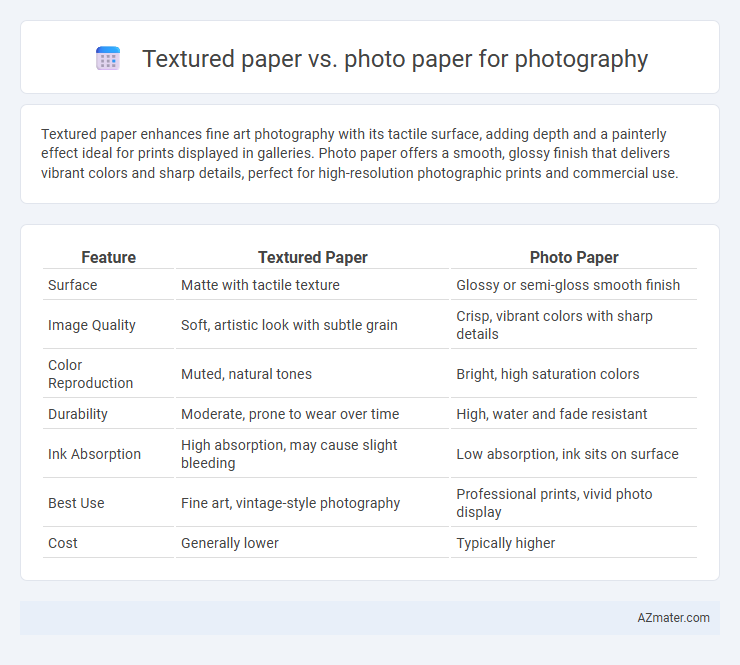Textured paper enhances fine art photography with its tactile surface, adding depth and a painterly effect ideal for prints displayed in galleries. Photo paper offers a smooth, glossy finish that delivers vibrant colors and sharp details, perfect for high-resolution photographic prints and commercial use.
Table of Comparison
| Feature | Textured Paper | Photo Paper |
|---|---|---|
| Surface | Matte with tactile texture | Glossy or semi-gloss smooth finish |
| Image Quality | Soft, artistic look with subtle grain | Crisp, vibrant colors with sharp details |
| Color Reproduction | Muted, natural tones | Bright, high saturation colors |
| Durability | Moderate, prone to wear over time | High, water and fade resistant |
| Ink Absorption | High absorption, may cause slight bleeding | Low absorption, ink sits on surface |
| Best Use | Fine art, vintage-style photography | Professional prints, vivid photo display |
| Cost | Generally lower | Typically higher |
Introduction to Textured Paper and Photo Paper
Textured paper features a tactile surface with intricate patterns that enhance the depth and artistic quality of photographic prints, making it ideal for fine art and portrait photography. Photo paper is designed with a smooth, glossy, or matte finish to ensure vivid color reproduction and sharp detail, optimizing the clarity and brightness of images. Choosing between textured and photo paper depends on the desired aesthetic, print durability, and the specific visual impact intended for the photographic presentation.
Key Differences Between Textured and Photo Paper
Textured paper features a tactile surface that enhances artistic photography by adding depth and dimension, making it ideal for fine art prints and portraits. Photo paper offers a smooth, glossy or matte finish designed to produce sharp, vibrant images with high color accuracy and detail, perfect for standard photo prints and commercial use. Key differences include surface texture, color vibrancy, and intended use, with textured paper providing a unique visual effect and photo paper emphasizing clarity and brightness.
Visual Impact: Texture vs. Gloss
Textured paper enhances photography by adding tactile dimension and depth, creating a painterly, artistic effect that softens images and reduces glare. Photo paper offers a glossy or satin finish, delivering vibrant colors, sharp details, and high contrast that make photographs appear more lifelike and vivid. Choosing between textured and photo paper depends on the desired visual impact: textured paper prioritizes subtlety and artistic expression, while photo paper emphasizes clarity and brightness.
Print Quality and Image Detail
Textured paper enhances print quality by adding depth and dimension to photographs, creating a tactile feel that emphasizes artistic elements and subtle shadows. Photo paper excels in preserving sharp image detail and vibrant colors, offering a smooth surface that maximizes clarity and contrast. Choosing between textured and photo paper depends on whether the priority is artistic expression with texture or crispness and color accuracy for photographic prints.
Color Reproduction and Tone Accuracy
Textured paper enhances color reproduction by adding depth and dimension, which can enrich the tonal range and create a more tactile visual experience in photography prints. Photo paper, especially glossy or semi-gloss varieties, provides sharper color accuracy and vibrant tones due to its smooth surface and optimized coating that intensifies color saturation. Choosing between textured and photo paper depends on whether the priority is artistic texture or precise color fidelity in photographic prints.
Durability and Longevity of Prints
Textured paper offers enhanced durability due to its fiber composition, resisting scratches and fingerprints better than photo paper, which is typically coated for vibrant color but more prone to surface damage. Photo paper excels in color vividness and sharpness but may degrade faster under UV exposure and frequent handling without protective coatings. Longevity of textured paper prints is often higher in archival conditions, making them ideal for fine art photography preservation.
Suitability for Different Photography Styles
Textured paper enhances fine art, black and white, and vintage photography by adding tactile depth and a painterly quality that complements grain and tonal variations. Photo paper is ideal for high-resolution, vibrant color images, such as portraits and wildlife photography, due to its smooth surface and ability to produce sharp details and vivid colors. Choosing between textured and photo paper depends on the desired visual impact and the specific style or mood of the photographic work.
Cost and Availability Comparison
Textured paper typically costs less than photo paper, making it a budget-friendly option for photographers seeking artistic effects without high expenses. Photo paper, especially glossy or high-gloss finishes, tends to be pricier due to its specialized coatings that enhance image clarity and color vibrancy. Availability varies as textured paper is widely accessible in craft and art supply stores, while photo paper is commonly found in photography or office supply shops and online retailers, with both options broadly stocked but photo paper ranges more specialized by finish and weight.
Choosing the Right Paper for Your Project
Textured paper offers a tactile surface that enhances artistic photography by adding depth and dimension, ideal for fine art prints and portraits. Photo paper provides a smooth, glossy or matte finish that delivers vibrant colors and sharp details, making it perfect for high-resolution images and commercial use. Choosing the right paper depends on the desired visual impact, print durability, and the specific photographic style you aim to highlight.
Final Thoughts: Which Paper Should You Choose?
Textured paper offers a tactile, artistic finish that enhances fine art and vintage-style photography by adding depth and character to prints. Photo paper delivers vibrant colors and sharp details, making it ideal for high-resolution images and professional photo displays. Choose textured paper for creative, gallery-quality prints, while photo paper suits projects demanding clarity and true-to-life color reproduction.

Infographic: Textured paper vs Photo paper for Photography
 azmater.com
azmater.com